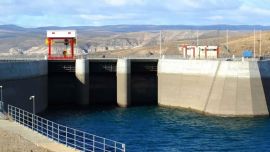Former president María Estela Martínez Cartas de Perón, more commonly known as Isabel Perón or simply ‘Isabelita,’ turned 90 on Thursday in the three-storey chalet on the outskirts of Madrid, where she has lived for the last four decades.
The first female vice-president and president in Argentine history, her presidency was nevertheless a deplorable presentation card for her gender as the most disastrous in Argentine history, opening the door to far worse – the brutal 1976-1983 military dictatorship.
Born in La Rioja as the youngest of six siblings in 1931, she rose from being a cabaret dancer in Panama to President of Argentina, purely as a result of teaming up with and eventually marrying Juan Domingo Perón, who handpicked her in 1973 as his running-mate for his third and last presidential term.
Keen on dancing from her earliest years (far less so on education with just five grades of schooling), at the age of 20 she joined a troupe directed by a pre-Castro Cuban who called himself ‘Joe Herald’ with the artistic name of ‘Isabelita Gómez,’ touring Latin America and performing in various nightclubs.
Although Panama-based, Isabel is actually believed to have met Juan Domingo Perón (35 years her senior) in Caracas at the Pasapoga cabaret in the last days of 1955, just three months after his overthrow. It seems to have been love at sight and they quickly became inseparable with the former president passing her off as his secretary (some accounts say that she introduced herself to him by offering to be his secretary).
They first lived together in Panama, followed by Venezuela and the Dominican Republic before Perón settled on Spain for his exile, where he finally married her in 1961, his third marriage. During those Puerta de Hierro years in Madrid, Perón twice named her as his personal delegate in Argentina.
Into power
Despite this expression of trust, Perón knew his wife too well to be convinced of her vice-presidential candidacy when there were finally free elections in Argentina in 1973 permitting him to run again. But his ambitious spouse reportedly swayed him with the argument: “The only person who won’t betray you is me.”
Yet as it turned out, the choice of running-mate was more anecdotal than it should have been because the election was theirs to lose – the Perón-Perón ticket swept to power in the September 23 presidential elections with a vote of 61.85 percent, the biggest landslide in Argentine history.
Just 40 weeks later, Argentina’s first female vice-president became Argentina’s first woman president, when General Perón died in his 79th year during the 1974 World Cup.
Even allowing for political and economic adversities and complexities both at home and abroad (with Montonero and leftist guerrillas already active, while the world was still recovering from the 1973-1974 OPEC oil price shock), her presidency was wholly negative – so much so that it becomes hard to say whether the harshest words for it come from fellow-Peronists or the opposition.
Wholly at sea, she turned to her Welfare minister, the sinister ex-policeman José López Rega, the creator of the right-wing paramilitary Triple A (Alianza Anticomunista Argentina) organisation, which did not hesitate to kill anybody opposed to it (including other Peronists as often as not), making him the strongman of her government.
To help the Triple A on its warpath, Isabel Perón signed the first of the “decrees of annihilation” later used by the military, police and parapolice to torture, kidnap and summarily execute anybody they liked.
Yet it was Economy Minister Celestino Rodrigo (actually one of eight Economy ministers during her presidency, lasting just six weeks) who probably did more to torpedo her presidency – his ‘Rodrigazo’ updating prices and the exchange rate to reality in the winter of 1975, when a two-year freeze was no longer sustainable, led to brutal austerity and a political crisis bringing López Rega down with him.
Soon afterwards, Perón’s despairing widow decided to bring forward the elections by seven months to October, 1976 but the military beat her to it with the March 24 coup led by General Jorge Videla, installing the “Process of National Reorganisation.” And beat her to it also in the sense of smashing all the negative records set by her chaotic rule in social, political and economic terms – above all, its crimes against humanity.
Exile
And Isabel? A helicopter conveyed the deposed president to house arrest in the Patagonian presidential residence El Messidor, followed by the naval base in Azul and San Vicente in Greater Buenos Aires. In 1981 she was released and moved back to Spain where she has lived a mostly isolated existence ever since, suffering fractures in a wrist, arm and hip in the past decade.
Returns to Argentina have been few and far between. In 1983 she attended Raúl Alfonsín’s presidential inauguration, joining Arturo Frondizi as the only other living constitutional ex-president. In exchange for that courtesy Alfonsín decided to ignore the suspected embezzlement of US$9 million of public funds into her private bank account (a crime for which the military regime had convicted her). Two more visits followed, the last in 1994 with then-Peronist president Carlos Menem (born in the same province) as her host.
Isabel Perón retained a passive nominal leadership of the Peronist movement until the eruption of Renewal Peronism in 1985, whereupon she vanished from politics and public sight until 2007, when under the Néstor Kirchner administration judicial investigations into the political murders during her brief government were launched, with the courts requesting her extradition from Spain. Although the famous judge Baltasar Garzón had previously summoned her over Triple AAA crimes (in 1997), the Spanish courts ruled that the charges fell under the statute of limitations.
Since last year Isabel Perón has set a new record as the ex-president living the longest after leaving office. Although still alive, she has already written her own epitaph: “I’m a humble woman of the people whose only merit is to have been a disciple of Perón and my love for Perón and the Argentine people.”


























Comments